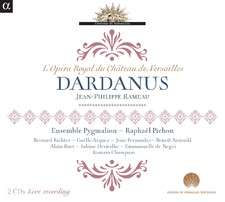|
Back
11/29/2013
Jean-Philippe Rameau: Dardanus
Bernard Richter (Dardanus), Gaëlle Arquez (Iphise), Benoît Arnould (Anténor), Joao Fernandes (Isménor), Alain Buet (Teucer), Sabine Devieilhe (Vénus, Une Phrygienne), Emmanuelle De Negri (Amour, Une Phrygienne), Romain Champion (Arcas), Ensemble Pygmalion, Raphaël Pichon (Conductor)
Recorded at the Royal Theatre, Versailles (February 14 & 16, 2012) – 145’
2 cds Alpha 951

   
This is certainly a delightful discovery!
Rameau composed his first version of Dardanus in 1739 and it was considered, if not an outright failure, a mixed success at best. He and his librettist made major changes for a revival in 1744. The improved version was staged again in 1760, when it was also published. As far as I can tell, this is the first recording of the final 1760 version.
The plot involves a princess, Iphise, who is in love with Dardanus, her father’s mortal enemy. Her father is the Phrygian king, Teucer, who wants her to marry an ally, Prince Anténor. With the help of a magician, Isménor, Iphise discovers that Dardanus is also in love with her. After various complications (during which Dardanus is imprisoned) and many noble sentiments expressed (librettist Charles-Antoine Leclerc de La Bruère was heavily influenced by Corneille), it all ends happily and there is celebratory dancing.
The work is categorized as a tragédie en musique but, although one character (conveniently) dies, it ends happily. It begins with the requisite prologue which, at almost 30 minutes, seems overlong. However the sparkling, characterful music carries it along (as it does the entire opera). Cupid banishes Jealousy from Cythera so that pleasure may calmly reign, but Venus declares that too much bliss leads to lethargy, so Jealousy and her retinue return and are invited to attend to the story of a warrior in love. Dance numbers are interspersed throughout this section and the entire work - in fact the legendary ballerina La Camargo performed in the 1739 presentation. It would ideally be staged by a company with a focus on dance and singing - Opera Atelier perhaps?
The recording was made during two concert performances at the Royal Theatre in the Palace of Versailles. Everyone was obviously well-prepared and there is a natural, airy acoustic. The only audience noise is applause at the end of each part.
The singers are all well chosen. Bernard Richter (Dardanus) is the only tenor in the cast and his glowing tone serves him well through the varied expressiveness demanded by the role. Mezzo-soprano Gaëlle Arquez gives a winning performance as the conflicted princess; she spends much of the time lamenting but the seemingly endless musical inventiveness of Rameau forestalls any hint of monotony.
The other main roles are all for lower voice, but there is welcome contrast between the three performers’ timbres. Benoît Arnould has an almost-tenor sound suitable for the ardent suitor (Anténor) who is sadly aware of the fact that his intended loves another. Alain Buet has the ideal voice for the closest thing the work has to a villain (King Teucer) as he seeks to kill Dardanus, not simply defeat him, until persuaded otherwise. Joao Fernandes skilfully uses his warm bass in the role of the sympathetic magician, Isménor. Sabine Devieilhe and Emmanuelle De Negri deliver vocal glitter as the immortals.
Not only is this a wonderful performance, but in addition the booklet contains the full libretto in French and English. The English translation is exceedingly flowery but we can blame the gallant, orotund original poetics for this. There are also informative articles in both languages, but frustratingly there is not a speck of information about the Ensemble Pygmalion or any of the performers. There are also 10 photos of the participants, but no captions.
Another small plus: the booklet’s design uses the attractive typeface called Rameau.)
The Ensemble Pygmalion was founded by Raphaël Pichon (b. 1984) in 2005. Judging from the aptly calibrated tempi and effervescent sound of the orchestra (21 players plus a “petit chœur” or continuo of eight) and chorus (20 members), the group is fully worthy of comparison with top-notch established companies such as Les Arts Florissants and Les Musiciens du Louvre. Highly recommended!
Michael Johnson
|